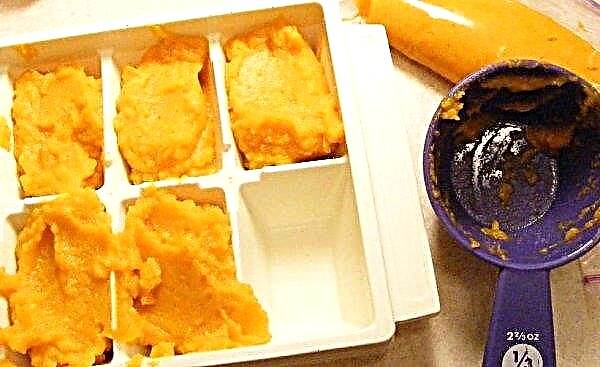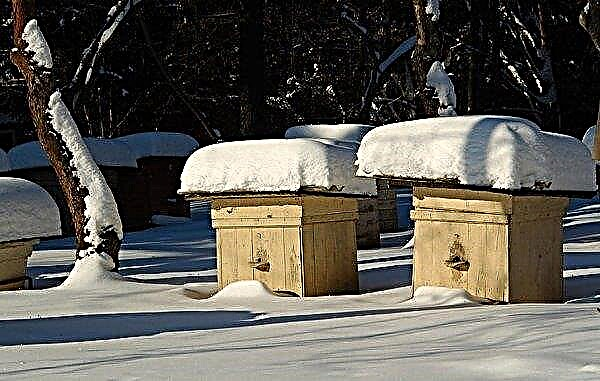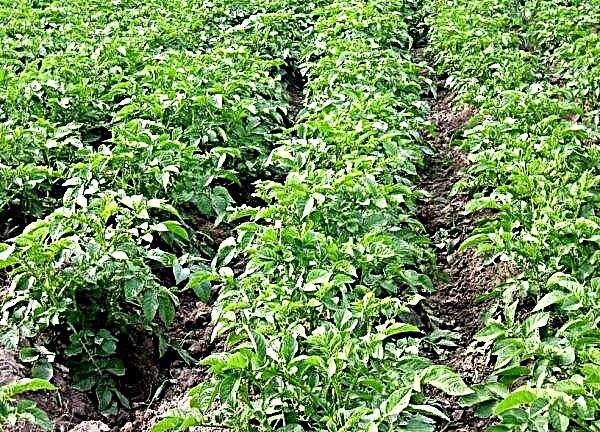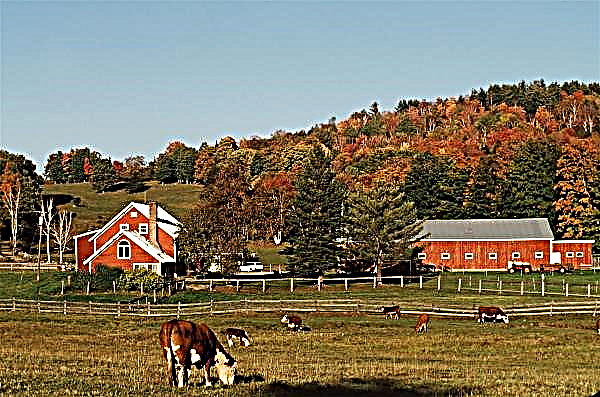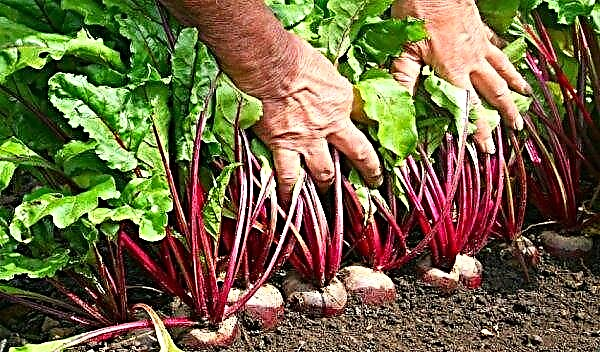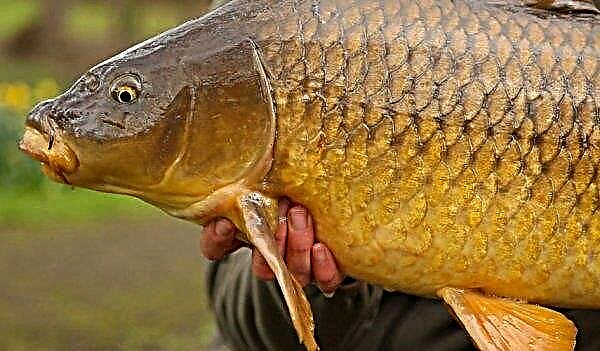Hydrangea Polistar is one of the new varieties of panicled hydrangea, which is a medium-sized bush with small flowers resembling asterisks in shape. The compact novelty is suitable for both growing on terraces and in flower gardens. To successfully grow a decorative plant at home, read its description and learn from the article how to plant a flower and take care of it.
Grade description
Panicled Hydrangea Polistar (Hydrangea paniculata Polestar) is a miniature bush reaching a height and width of up to 50 cm. It blooms from June to September. The flowers are small, at the very beginning of flowering are white, with a slight greenish tint. In July, salmon, and closer to August, acquire a dark pink color. Large inflorescences are conical in shape and reach a diameter of 30 cm. The leaves are small, bright green. The variety has an average resistance to frost (able to withstand cooling to –23 ° C).
Important! Bulbous flowers: tulips, gladioli and hyacinths cannot be planted near hydrangeas. These plants require regular transplantation, which can damage the sprawling root system of the shrub.
Landscape design application
Ornamental shrubs are grown to decorate balconies and terraces. The miniature plant is suitable for planting in the garden in combination with flowers and other deciduous bushes. In flowerbeds, it looks good together with other varieties of panicle hydrangea: Grandiflora, Mega Pearl, White Goliath, Kiusu, etc. You can plant in groups along alleys and garden paths.
Landing
The survival rate and development depends on how well the bush will be planted. It is important to treat the upcoming event responsibly and competently prepare for it.
Preparing for landing includes the following steps:
- Choose a place.
- Set the stage.
- Determine the timing suitable for planting.
- Prepare planting material.
Site selection and soil preparation
Well-lit places are suitable for planting hydrangeas. However, at noon it is advisable to shade the plant from the scorching sun. The best option would be a place near the trees. The selected area must be reliably protected from the wind. Before planting it must be thoroughly loosened and cleaned of weeds.

A fertile land of neutral acidity (pH 5.5) is suitable for hydrangea cultivation. Alkaline soil can be deoxidized with brown peat, coniferous earth or sawdust. These shrubs do not grow in sandy soils.
Landing time
Planting should be carried out in the spring, before sap flow begins, or in autumn, when the leaves fall. Plants planted in spring will bloom in early summer. If planting is planned in the fall, you need to take care of sheltering a young shrub for the winter.
 As a planting material, 5-year-old seedlings are suitable. Instances of this age can quickly take root and bloom in the year of planting. The root system of seedlings needs to be shortened a little and placed for a day in a container with water. In water, you can dilute a growth stimulator, for example, "Kornevin."
As a planting material, 5-year-old seedlings are suitable. Instances of this age can quickly take root and bloom in the year of planting. The root system of seedlings needs to be shortened a little and placed for a day in a container with water. In water, you can dilute a growth stimulator, for example, "Kornevin."
Step-by-step instruction
Having prepared everything you need, you can start planting.
Important! The distance between the bushes should be at least 1–1.5 m.
Landing pattern:
- Dig a hole 50 cm in diameter, while observing a depth of 40 cm.
- Pour 2–3 buckets of water into the excavated hole and allow the soil to soak in moisture until the next day.
- Prepare the soil mixture. To do this, mix fertile soil (chernozem), sand, peat and humus in a ratio of 2: 1: 2: 1. Add 25 g of urea and the same amount of potassium sulfate, as well as 65 g of superphosphate. Mix all components.
- Pour the prepared substrate into the pit so that it almost completely fills it.
- Wait until the soil settles and settles.
- Place the seedling in the pit, carefully distributing the roots.
- Cover the ground so that the root neck rises slightly above the surface of the earth.
- Water by pouring 1-2 buckets of water.
- Sprinkle mulch around the trunk using crumbling needles, foliage and sour peat.
 After planting, it is necessary to protect the young bush from exposure to the sun. To this end, it can be slightly shaded.
After planting, it is necessary to protect the young bush from exposure to the sun. To this end, it can be slightly shaded.
Care
Subject to the rules of planting, caring for a young plant will not be difficult. It is only necessary to take into account the features of growing shrubs and give him enough attention and time.
Elements of plant care:
- watering;
- top dressing;
- pruning
- shelter for the winter.
Watering and feeding
All varieties of panicled hydrangea belong to plants that prefer a moist environment. Watering these shrubs requires regular, you need to pour about 3 buckets of water weekly under one plant. It is also important to ensure that the soil where the bush grows is always moist, but not wet. In the hot season, watering should be done more often, especially since hydrangea blooms in the summer. So, in the hot months, you need to water the shrub twice a week with three buckets of water in the morning or evening.

After watering, it is recommended to loosen the soil and cover it with a 5-cm layer of pine needles or sawdust. This will help retain moisture in the soil and prevent drying out. With excessive moisture, the soil must be loosened, sprinkled with sawdust and stop watering for a while. Remove the moisture-soaked mulch layer and fill it with new.
Hydrangea should be fed 2 times in the spring, 1 time in the summer and in the fall. In the spring, when sap flow begins (March - early April), organic fertilizers, for example, a solution of bird droppings, must be introduced into the earth around the bush. For 12 liters of water there is 500 g of litter. Pour 0.5 liters under one bush. When the buds begin to ripen, the following top dressing should be added: dissolve sulfuric potassium (35 g), superphosphate (35 g) and urea (25 g) per 1 m² in 10 l of water. Pour the soil around the shrub with the resulting solution.

In July, make the third top dressing. For its preparation, complex mineral fertilizers are used. Typically, such top dressing is produced in the form of granules. Pour 25–35 g into a bucket of water and stir until dissolved. Approximately 2–3 buckets are consumed per plant. The fourth time the bush is fed in the fall, in preparation for winter. To do this, it is recommended to use ready-made fertilizers suitable for hydrangeas, which do not contain nitrogen.
Trimming and Shaping
To create a decorative form, the crown of the bush must be trimmed in a timely manner. Hydrangeas are pruned in early spring, leaving 5–10 of the most viable shoots. They should be shortened to 3-5 kidneys. All other branches are removed almost to the base, so that only hemp remains. In order for an older plant to give young shoots, it can be rejuvenated by cutting all shoots to 6–7 cm from the base.
 For sanitary purposes, all frost-bitten and dry branches are removed.
For sanitary purposes, all frost-bitten and dry branches are removed.
Shelter for the winter
Preparing the shrub for winter should be based on the climatic conditions in which it grows. In a warm climate, there is no need to cover hydrangea. In the cold, for example, in the Urals and Siberia, frost protection is sure to be needed. In central Russia, bushes are sheltered only if winter is expected to be frosty and not snowy. You should also provide heat to a young plant planted in the fall, on the eve of cold weather. Such a need is explained by the fact that fragile shoots and roots, exposed to the cold, can suffer from frostbite and subsequently die.
Grade Polistar does not have pronounced frost-resistant properties and is able to withstand cold to –23 ° C. Given the plant's predisposition to heat, when planting in the northern latitudes, it is necessary to take care of the warming of the young bush. As a shelter can serve as a burlap. She needs to wrap the bush. You can warm the soil around the trunk with a layer (20 cm) of dry leaves, sawdust, fallen needles and peat. After the first snowfall, you can form a snowdrift around hydrangea.

Diseases and Pests
Most often, hydrangea Polistar becomes the object of an aphid attack. You can get rid of the parasite with the help of garlic and soap. To prepare the garlic solution, you need to grind 250 g of cloves and fill them with a bucket of water. Then insist for 2 days. Next, add 50 g of grated laundry soap to the resulting solution, mix until completely dissolved and spray the bush well. It is important that the leaves are processed on both sides. Spray with a solution of garlic every week until the aphid completely disappears.
 In addition to the infusion, you can try to treat the plant with acaricides, for example, Akarin and Aktara.
In addition to the infusion, you can try to treat the plant with acaricides, for example, Akarin and Aktara.
Among hydrangea diseases, powdery mildew is more common. You can cure the plant by treating it with 1% Bordeaux liquid or Fundazole solution. To do this, you need to dilute 25 g of the product in 10 liters of water and spray the shrub. To avoid the spread of diseases and parasites, all plants in the garden should be inspected regularly, and at the first sign of damage take action.
Did you know? On the Buddha’s birthday, it is customary for Buddhists to decorate temples with hydrangea flowers.
Breeding methods
To grow several copies in your garden at once, it is not necessary to purchase seedlings in the store. Instead, you can try to propagate the bushes yourself. As a result, you can get healthy and strong plants, the survival of which is more successful than that of purchased ones. Plants propagated at home, easier to transfer the transplant to the main place. Read more about hydrangea propagation methods - hereinafter.
Hydrangea propagation methods:
- by seeds;
- cuttings.
Video: three ways to propagate hydrangea
Seeds
In October, you need to collect the seeds and leave them in a dry, dark place until February. When the time is right, the seeds should be germinated. To do this, they can be put on gauze or cotton wool soaked in water. After swelling, you need to prepare the substrate, mixing humus, sand and peat in equal proportions and fill the container with the prepared mixture. Then spread the swollen seedlings on the surface of the substrate and sprinkle them with a layer of sand.
It is not worth digging seeds. Next, you need to create a greenhouse by covering the container with glass or cling film. Periodically spray the seed with a spray gun. After a few weeks, the first sprouts will appear. After the formation of the second leaves, the plants can be planted in separate pots.

Further care of seedlings involves:
- Watering and loosening. The earth should always be moist, but not wet. Loosening allows the soil to better pass water and oxygen, and also prevents the formation of earth crust.
- Spraying. Immature plants need additional hydration.
- Provide the optimum amount of light. The place where the seedlings grow should be bright, but at the same time hidden from direct sunlight.
- Fertilizer. Young hydrangea should be fed during the growing season. For this, twice a month the soil needs to be fertilized with complex top dressings, such as Agricola, Golden Spark. In autumn, the amount and frequency of top dressing is reduced, and in the winter it is stopped.
- Maintaining soil acidity. Each month, the soil should be acidified with a solution of vinegar or citric acid.
 Seedlings grown from seeds can be planted in open ground after 2 years.
Seedlings grown from seeds can be planted in open ground after 2 years.
Cuttings
Cuttings are the most popular method of propagation of hydrangea bushes. For this, shoots cut in spring with 4–5 buds are suitable. Dip the cuttings in water with the addition of "Kornevin" for 2 days. Then fill the container with acidified soil and deepen the cuttings into 2 kidneys into it. The earth must be moistened periodically.
Did you know? The name "hydrangea" consists of two Greek words Hydor and Angos, which means "water" and "vessel". This phrase reflects the moisture-loving qualities of this plant.
Before the first foliage, plants need to be shaded. Later shading is gradually removed. Before the onset of cold weather, young seedlings should be covered with spruce branches. With the onset of summer, the buds are removed so that the flowering does not deprive the immature plant of nutrients. Seedlings are planted in a permanent place in the garden after 4–5 years.
Panicled Hydrangea Polistar is a wonderful decoration of flower gardens. It can be grown from cuttings and seeds. After planting on a site, it is important for the plant to provide conditions suitable for growth and full development. Subject to the simple requirements for planting and care, the bush will thank the owner with luxurious flowering for many years.



